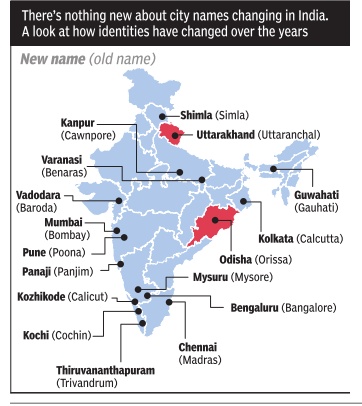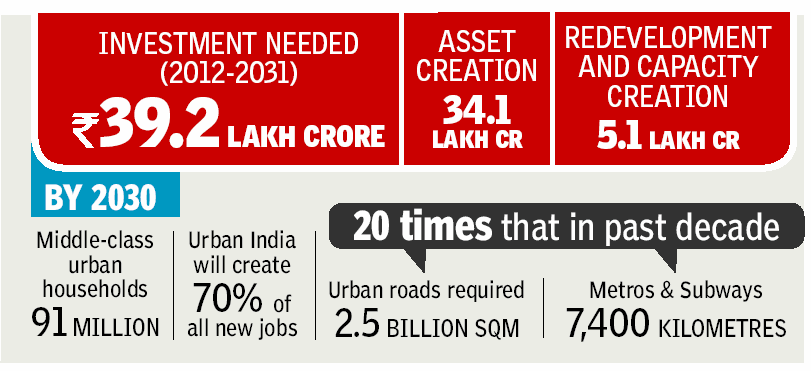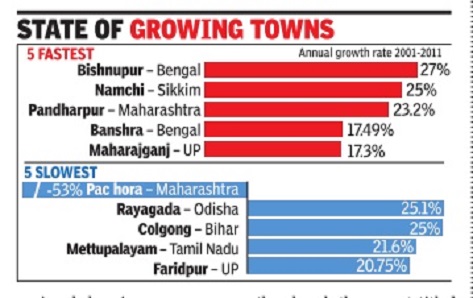Cities of India: issues

This is a collection of newspaper articles selected for the excellence of their content. |
Contents |
The financial health of India’s main municipal bodies
Detroit is broke, Indian cities limping too
Surojit Gupta, TNN | Jul 23, 2013
NEW DELHI: Drive to any Indian city. Chances are you will wade into chaotic traffic and roads full of potholes. You'll see choked drains, overflowing and smelly bins and streetlights that don't work.
The reason for the mess isn't difficult to unravel. Most of our municipal bodies are cash strapped, unable to take care of the city's needs. The workforce is poor. Given the indifferent reputation of urban bodies, they tend to attract talent that can't rise to the challenges at hand.
An assessment of our cities following the Detroit debacle shows how a lethal mix of mismanagement and lack of autonomy is driving our cities into chaos and possibly, collapse, if not addressed urgently.
Bangalore
Take Bangalore - a city showcased as India's answer to Silicon Valley. Work on the city underpasses has remained unfinished and sweepers can't be paid as the Bruhath Bangalore MahanagaraPalike (BBMP) is broke. The BBMP's outstanding bills stand at Rs 1,300 crore as on July 19.
The civic body has taken loans of over Rs 3,365 crore. Contractors hired by BBMP have stopped civic works in protest.
Bhopal
Bhopal's story is no different. The municipal corporation's finances are weighed down by staff salaries and the growing city's needs. Although funds from the Jawaharlal Nehru National Urban Renewal Mission (JNNURM) breathed some life into the civic body, its health remains precarious.
Kolkata
The Kolkata Municipal Corporation (KMC) is no better. Efforts are on to boost revenues through improved property tax collection. The KMC's total budget is Rs 3,500 crore. Of this, Rs 1,900 crore comes from government grants. It generates Rs 1,600 crore. The total expenditure is Rs 3,400 crore. That leaves very little for development work.
Panaji
In Goa, the Panaji Corporation too is passing through difficult times. It depends on the government for staff salaries and other expenses. Revenue generation is shoddy.
Kochi
The picture is as bleak in Kochi. The civic body depends on property, advertisement, entertainment and professional taxes and grants from the central and state governments. It expects to generate Rs 877.97 crore in 2013-14 against an estimated expense of Rs 849.86 crore. "The corporation is cash-strapped and depends on the state to execute big infrastructure projects. Bulk of its income goes in paying salaries and pensions," Mayor Tony Chammany said. Worsening matters is the civic body's inability to collect property tax dues and user charges. Citizens stubbornly resist paying and the state's powerlessness is inexplicable.
The compact between the service provider and recipient has collapsed when it comes to civic bodies. Most of them survive on funds from the centre and states and the trickle that comes in as taxes.
Jaipur
"State government assistance keeps the Jaipur Municipal Corporation afloat. Most of our earnings go in paying our 8,000-strong staff," Nita Khaitan, chairperson, JMC finance committee, says. Municipal bodies across UP are limping.
UP: KAVL towns
Lucknow municipal commissioner RK Singh told TOI almost all big city corporations such as Allahabad, Varanasi and Kanpur have no more than Rs 100-125 crore to carry out repair and maintenance - a pittance when seen against the enormity of the work needed to lick these decrepit cities into shape. TOI spoke to municipal corporations in major cities across the country and the story was strikingly similar: Financial crunch, lack of governance and autonomy, factionalism, political interference and overstaffing were endemic.
The exceptional few
A handful of cities though have bucked this trend - Ahmedabad, New Delhi, Mumbai, Nashik and Nagpur for instance. Experts say municipal corporations need greater autonomy and better fiscal management. These would help urbanization and make cities growth engines. This becomes imperative as more people flock to cities for jobs, education and a better life.
Indian cities: Environmental issues
Cities turn into concrete ovens
Jayashree Nandi | TNN 2013/06/05
Surat
Cities are creaking under their own weight. And heat. In Surat, for instance, parts of the city with dense concrete jungles swelter at temperatures 5 degrees higher than the city’s greener parts. This phenomenon, of parts of a city having higher temperature than the remaining areas, is called an ‘urban heat island’ (UHI) and till recently was associated with big metros. But the phenomenon has now spread to India’s smaller cities and towns.
Coimbatore
In the lush Western Ghats, parts of Coimbatore today are comparable to any concrete city in China, says Kiran Rajashekariah, a World Wide Fund for Nature (WWF) researcher. Between 2004 and 2010, urban sprawl has doubled, so has the built-up area. The region’s elephant corridors are choked by real estate projects, elephants frequently killed in accidents on roads and rail tracks. The city also has a satellite town coming up, an Indo-Dubai residential venture spread over 1,200 acres, built in the middle of an elephant corridor.
Gangtok
Cool, breezy Gangtok is today neither cool, nor breezy. Hotelier Karma Tenpa says he takes half an hour to cover the one-kilometre distance from his home to MG Marg. “I’d rather walk” says Tenpa, fed up with traffic jams, a common occurrence with a rapid increase in cars. There is barely space to park in the hilly terrain.
Tier II cities
India’s tier II cities are transforming at a monstrous pace — UHI, traffic congestion, air and water pollution becoming urgent environmental concerns. In every part of the country, unplanned, rapid and rampant urbanisation is pushing these smaller cities to a sick state.
None more so than industrial sub-cities Narela and Bawana are close to burning. “These areas show a temperature difference of 10 to 15 degrees,” says Teri researcher, Richa Sharma who documented Surat’s UHI phenomenon. With several UHI pockets, the city’s cooling demands have shot up, feeding into a vicious cycle of air-conditioning creating more heat.
Vehicular pollution
Vehicular pollution is also wreaking havoc. Chandigarh, a class III city population-wise, has a motorization rate higher than mega cities, says a Centre for Science and Environment report. Between 2010 and 2011, number of vehicles increased by 38 % in contrast to 9% in Bangalore, 15% in Delhi. Chandigarh has 227 cars per 1,000 people, Delhi 117 per 1,000. Kanpur with way fewer vehicles than Delhi, has a congestion index close to the capital’s. “Bhiwadi, near Jaipur is promoted by government and developers as India’s third-largest industrial hub. It has township projects, IT hubs; all sorts of industry. The volume of effluents generated is far greater than the treatment capacity. Majority of effluent flows into low-lying areas,” says Anumita Roychowdhury, CSE.
Gurgaon and Ghaziabad are prime examples of the unplanned boom. Gurgaon resident Sugandh Sinha recollects how her apartment did not have full power backup. So, in the long outages that could stretch to over eight hours, residents used diesel gen-sets.
RIVERS GOING BUST
Dead water bodies in parched cities are another ogre. Gujarat’s glorified growth story comes a cropper in the face of the toxic levels in its industrial clusters and river bodies that have touched new highs. Amlakhadi in Ankleshwar or Damanganga River in Vapi figured right up there in a ranking of South Asia’s most polluted sites.
River Noyyal, once a source of drinking water for Coimbatore is a “cesspool” now and farmers consider it a “curse” because it pollutes their fields every year. Dye discharge from dyeing industries have killed Noyyal, adds WWF’s Kiran.
Mula-Mutha | Pune
Musi | Hyderabad
Khan | Indore
Sabarmati | Ahmedabad
Vishwamitri | Vadodara
Noyyal | Coimbatore
Karamana | Thiruvananthapuram
Cooum | Chennai
Gomati | Lucknow
The UN Framework Convention on Climate Change
Nitin Sethi 2013/06/05
Negotiations under the UN Framework Convention on Climate Change never hinged on what science told nations, nor did leaders react as urgently as science urged them to. Had that been so, the 2009 Copenhagen meeting on the back of a calamitous IPCC report would’ve got the US to agree to urgent emission cuts. It would’ve forced EU to do more and forced China, Brazil, India and South Africa to greater responsibility.
Infrastructure
Small towns (less than one lakh population): infrastructure
Dipak Dash, `Small towns hurtling towards infra hellhole,' Oct 04 2016 : The Times of India
The government has a mammoth task to make the cities sustainable and also to ensure that towns with less than one lakh population get required infrastructure before they end up becoming urban mess, two reports released by housing ministry said.
While report on India's small towns depicts grim picture of inadequate infrastructure in these mushrooming urban settlements, particularly those with population of 5,000 to 20,000, the other report on Habitat management has recommended to take measures to reduce water and power use and promote regional planning.
These recommendations gain importance considering the fact that over 37 crore people live in urban areas and another 18 crore people live in rural areas close to nearly 70 largest urban centres. On the other hand, the report titled “Towns of India“ shows how the number of towns with less than one lakh population has increased from 3,984 in 2001 to 5,705 in 2011and how they lack basic infrastructure and socio-economic indicators.
Management of cities
Three areas of concern

From: April 7, 2018: The Times of India
See graphic:
2018: A study of 23 cities by nonprofits Janaagraha Centre for Citizenship and Democracy and Jana Urban Space Foundation found several gaps in how cities are managed, especially in the three areas of staff vacancies, management and availability of funds, and transparency
Indian cities have been growing rapidly despite shortcomings in infrastructure and urban planning. A study of 23 cities by nonprofits Janaagraha Centre for Citizenship and Democracy and Jana Urban Space Foundation found several gaps in how cities are managed, especially in the three areas of staff vacancies, management and availability of funds, and transparency. The highlights here
See also
Cities of India: the best and the worst
Cities of India: issues
Cleanliness ranks of Indian cities, districts: 2014-15






